Plot summary
The starship Gloria Mundi, built and crewed by the United States of Europe, lands on the planet Altair Five in the year 2032. When part of the crew ventures out to explore the region around their touchdown point, their radio communication soon ceases and they do not return. Three of the crew sent to rescue their mates vanish within hours. Of the three remaining, all of whom are captured after they finally leave the ship in search of the missing, only psychiatrist Paul Marlow, the book's protagonist, survives. The planet is inhabited by primeval humanoids.
A central theme in the novel is the clash between Marlowe's rational worldview and the indigenous peoples' superstitious and often brutal culture. His name is pronounced Poul Mer Lo by the Bayani tribe he lives amongst; he gains a leading position in the primitive society.
Marlow eventually goes on a journey which has the result of demystifying the natives' religion by discovering its factual origin - thereby uncovering that the humans of Altair Five share their ancestry with humans of Earth and of other worlds in the Milky Way.
When he returns from this journey, he is raised to the most powerful position within the society. Marlow uses this power to educate the alien race; he introduces them to writing, to transforming Earth inventions such as the wheel, the ball-bearing and the axle, and to better industrial and agricultural methods.
While throughout his stay on this world, Marlow has longed to go home, he reaches a point where he adapts to the simplicity and naivety of the Bayani lifestyle, and starts seeing the complexities of Earth as absurd. When, after less than three Altair Five years, he is contacted by a starship and rescue is imminent, he decides to stay in spite of a specific fate which awaits him.

Forbidden Planet is a 1956 American science fiction film from Metro-Goldwyn-Mayer, produced by Nicholas Nayfack, and directed by Fred M. Wilcox from a script by Cyril Hume that was based on an original film story by Allen Adler and Irving Block. It stars Walter Pidgeon, Anne Francis, and Leslie Nielsen. Shot in Eastmancolor and CinemaScope, it is considered one of the great science fiction films of the 1950s, a precursor of contemporary science fiction cinema. The characters and isolated setting have been compared to those in William Shakespeare's The Tempest, and the plot contains certain happenings analogous to the play, leading many to consider it a loose adaptation.
Lazarus Long is a fictional character featured in a number of science fiction novels by Robert A. Heinlein. Born in 1912 in the third generation of a selective breeding experiment run by the Ira Howard Foundation, Lazarus becomes unusually long-lived, living well over two thousand years with the aid of occasional rejuvenation treatments. Heinlein "patterned" Long on science fiction writer Edward E. Smith, mixed with Jack Williamson's fictional Giles Habibula.
A sleeper ship is a hypothetical type of crewed spacecraft, or starship in which most or all of the crew spend the journey in some form of hibernation or suspended animation. The only known technology that allows long-term suspended animation of humans is the freezing of early-stage human embryos through embryo cryopreservation, which is behind the concept of embryo space colonization.
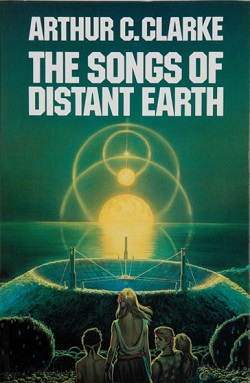
The Songs of Distant Earth is a 1986 science fiction novel by British writer Arthur C. Clarke, based upon his 1958 short story of the same title. Of all of his novels, Clarke stated that this was his favourite. Prior to the publishing of the novel, Clarke also wrote a short step outline with the same title, published in Omni magazine and anthologised in The Sentinel in 1983.
The Uplift Universe is a fictional universe created by American science fiction writer David Brin. A central feature in this universe is the process of biological uplift.

Eden is a 1958 social science fiction novel by Polish writer Stanisław Lem. It was first published in 1958 in issues 211-271 of the newspaper Trybuna Robotnicza. The first book edition was in 1959. It was first published in English in 1989 (ISBN 0-15-127580-7).
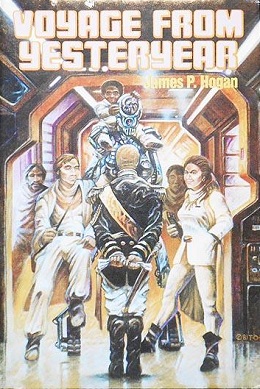
Voyage from Yesteryear is a 1982 science fiction novel by British writer James P. Hogan.

Homeward Bound (2004) is a science fiction and alternate history novel by Harry Turtledove. It is the eighth and final work in his Worldwar series fictional universe. It follows the events of the Colonization trilogy and gives some closure to the storylines.
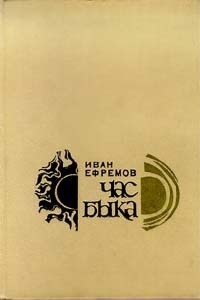
The Hour of the Bull is a social science fiction novel written by Soviet author and paleontologist Ivan Yefremov in 1968. Six months after its publication in book form in 1970 Soviet authorities attempted to remove it from libraries and bookshops after realizing that it contained a sharp criticism of the current state of affairs in the USSR disguised as a critique of "Capitalism" and Chinese-style communism of that time. It was published again in the 1980s "perestrojka" and thereafter.

Non-Stop is a 1958 science fiction novel by British writer Brian Aldiss. It is about problems that the inhabitants of a huge generation space ship face after an alien amino acid that they picked up on another planet triggers a pandemic. Law and order began to collapse, and knowledge of the ship and of its purpose was eventually almost entirely lost throughout the vessel.
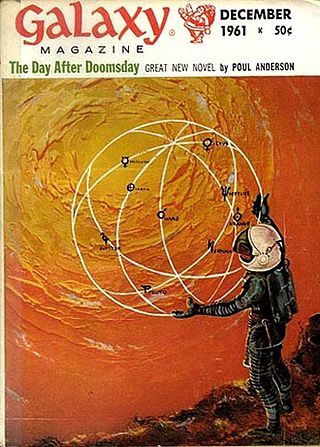
After Doomsday is a science fiction novel by American writer Poul Anderson. It was published as a complete novel in 1962, having been serialized as The Day after Doomsday in the magazine Galaxy, between December 1961 and February 1962.
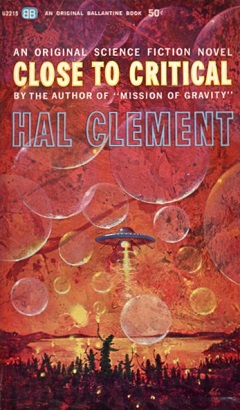
Close to Critical is a science fiction novel by American writer Hal Clement. The novel was first serialized in three parts and published in Astounding Science Fiction magazine in 1958. Its first hardcover book publication was in July 1964.

The Wizard of Linn is a science fiction novel by American writer A. E. van Vogt, a sequel to Empire of the Atom. The novel was originally serialized in the science fiction magazine Astounding Science Fiction. It was first published in book form in Germany in 1961 by Terra Sonderband, as Der Zauberer von Linn.

Dying Earth is a subgenre of science fantasy or science fiction which takes place in the far future at either the end of life on Earth or the end of time, when the laws of the universe themselves fail. Dominant themes include world-weariness, innocence, idealism, entropy, heat death of the universe, exhaustion or depletion of many or all resources, and the hope of renewal. A related subgenre set in the distant future of entropic decay is called entropic romance.

Planet of Light is a science fiction novel by American writer Raymond F. Jones, first published in 1953 by the John C. Winston Co. as part of its 35-book set of juvenile novels. Written as a sequel to Son of the Stars, the story follows Ron Barron and his family as they are taken to a planet in the Great Galaxy of Andromeda to participate in a meeting of an intergalactic analogue of the United Nations. They face the question if Earth is ready to join an intergalactic society.

The Enemy Stars, is a science fiction novel by American writer Poul Anderson, published in 1959 by J.B Lippincott in the US and by Longmans in Canada. Originally published in Astounding Science Fiction under the title We Have Fed Our Sea__, it was a nominee for the 1959 Hugo Award for Best Novel. The original title refers to a line in a poem by Rudyard Kipling.
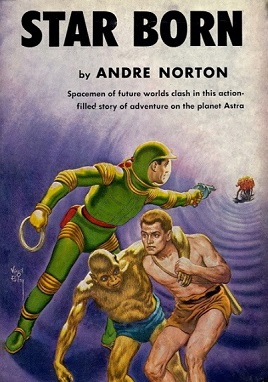
Star Born is a science fiction novel by American writer Andre Norton, first published in 1957 by World Publishing Company of Cleveland. As the sequel to The Stars Are Ours!, Star Born continues its predecessor's adventure three generations later.

Starship Through Space is a science-fiction novel written by G. Harry Stine under the pseudonym Lee Correy. It was published in 1954 by Henry Holt and Company. The book tells the story of the building of the first starship and of its flight to Alpha Centauri.

"The Gold at the Starbow's End" is a science fiction novella by American writer Frederik Pohl. Originally published in the March 1972 issue of Analog Science Fiction/Science Fact, it was nominated for both the 1973 Hugo Award for Best Novella and the 1973 Nebula Award for Best Novella. It did win the 1973 Locus Award for Best Novella.
















